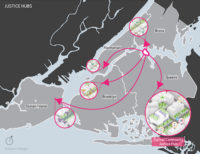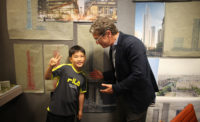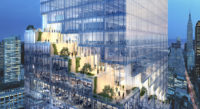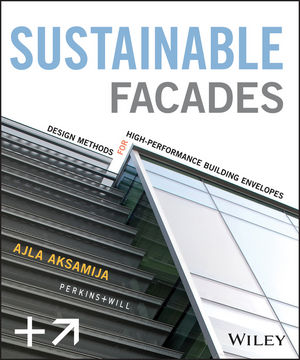KPF Proposes Mile High Skyscraper

The Sky Mile Tower, KPF’s ambitious proposal, features slots to increase aerodynamic performance.
Image © KPF

Next Tokyo would bridge Tokyo Bay, allowing for easy transportation and storm protection.
Image © KPF


“He is not dreaming,” the Chicago Tribune confirmed in 1956 after an 87-year-old Frank Lloyd Wright declared that he could build a milehigh skyscraper near the city’s Adler Planetarium. “If we are going to have centralization, why not quit fooling around and have it,” Wright, reclining at home in Spring Green, Wisconsin, told the reporter briskly.
Decades later, the mile race is still under way— and heating up: according to data released by the Council for Tall Buildings and Urban Habitat (CTBUH), 2015 was the highest year on record for tall buildings, with 106 new skyscrapers reaching completion. In just two years’ time, Adrian Smith + Gordon Gill Architecture’s Jeddah Tower will soar more than a kilometer over Saudi Arabia.
Now Kohn Pedersen Fox Associates is upping the ante with its proposal for Next Tokyo, a conceptual Japanese megacity for a half million residents, with a mile-high tower at its center. According to the architects, such a building could be achieved in the near future. “Part of the vision we proposed is what the world might look like in 2045. It’s meant to be a plausible vision,” says KPF principal David Malott, who led the project.
Strangely, a television show kicked off KPF’s investigation. The firm—responsible for some of the world’s tallest buildings, including the 600-meter Ping An Financial Centre in Shenzhen, China (to be completed this year), and three towers that will soon fill New York’s Hudson Yards—was approached by Japanese broadcasting organization NHK to design a tower for its series Next World (think Nova, but flashier). “Originally it started as just a tower, but we didn’t want to do something high for its own sake,” explains Malott. “So we needed a story that would justify the height.”
That narrative is grounded in the environmental and societal pressures facing Japan, including rapid urbanization and natural extremes. For Japan, the latter is particularly resonant given the earthquake and tsunami that killed more than 16,000 people just five years ago. The Japanese government has proposed a multibillion-dollar concrete seawall to shield 250 miles of coastline, disparagingly nicknamed “the Great Wall of Japan.” As an alternative, KPF, in collaboration with structural engineers Leslie E. Robertson Associates, decided to devise a proposal that melds architecture with infrastructure.
The future city would occupy a five-square-mile landfill district spanning a narrow point in Tokyo Bay (a nod to an unbuilt plan architect Kenzo Tange formulated 50 years ago) to create both a protective barrier and integrate the metropolitan area. A mile-high tower cannot exist in isolation, Malott says: “It needs to be a part of a community, with a supporting cast of towers.”
In renderings, the lower skyscrapers that would comprise Next Tokyo look like a cluster of reeds rising from the bay. When designing the central Sky Mile Tower, the team conducted a series of wind tunnel tests, which showed that a tapered, slotted design had the best aerodynamic performance. “A lot of people think when you build a tower in Japan, earthquakes will create the most difficulty,” Malott explains. “It’s actually the wind.”
To mitigate the effects of high winds, the design for Sky Mile Tower consists of sequences of three legs, rotated in plan as they move up the tower, allowing for large vertical slots through the building. Megabracing and concrete shear walls provide the basic lateral system. For vertical transportation throughout the building, the architects consulted ThyssenKrupp, which is developing self-propelled elevators that would run in a loop. To address the challenge of pumping water to such dizzying heights, the building’s skin would capture water from clouds. What appear to be hexagonal lily pads at the tower’s base are actually atoll-like arrangements of terraced, mid-rise residential buildings, with reservoirs of desalinated bay water at the center. The configuration would buffer the higher-density zones from sea waves. The plan also calls for other infrastructure, including Hyperloop, a pneumatic transport system.
KPF’s television episode aired in Japan last year, and the firm went on to publish its findings in the CTBUH Journal soon after. The design was greeted with relative silence until last month, when the proposal ricocheted through the western mainstream media with sensationalistic declarations including “Developers plan to build a futuristic megacity” and “Move over, Burj Khalifa.” The architects caution there are no current plans to execute the project, but with technology progressing as it has, the sky’s the limit for towers. Says Malott, “It’s certainly far-reaching and forward-thinking, but grounded in what could be practically achieved.”







